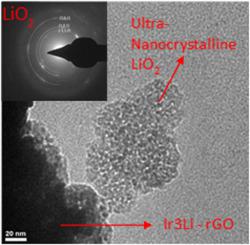Nano Energy ( IF 17.6 ) Pub Date : 2021-09-22 , DOI: 10.1016/j.nanoen.2021.106549 Samuel T. Plunkett 1, 2 , Chengji Zhang 1, 3 , Kah Chun Lau 4 , Megan R. Kephart 1 , JG Wen 5 , Duck Young Chung 1 , Daniel Phelan 1 , Yang Ren 6 , Khalil Amine 7 , Said Al-Hallaj 2 , Brian P. Chaplin 2 , Hsien-Hau Wang 1 , Larry A. Curtiss 1

|
Current lithium-oxygen (Li-O2) batteries suffer from large charge overpotentials related to electronic resistivity of the insulating lithium peroxide (Li2O2) discharge product. One potential solution to this challenge is the stabilization of the lithium superoxide (LiO2) discharge intermediate, which has much higher electronic conductivity compared to Li2O2. Cathodes based on small iridium (Ir) nanoparticles have been recently used in a Li-O2 battery to successfully stabilize the LiO2 product, however, the LiO2 had a short lifetime. In the previous study, researchers found that the LiO2 was stabilized on Ir3Li surfaces which were formed from Ir nanoparticles during battery operation. Little is known about the electronic properties of Ir3Li and its role in stabilizing LiO2 product formation. This work provides the first study of the electronic properties of Ir3Li, which was thermally synthesized in bulk prior to implementation on the reduced graphene oxide (rGO) cathode of a Li-O2 cell. The bulk Ir3Li was found to have comparable electrical conductivity to Ir metal, possess metal-like magnetic properties, and has an affinity towards O2 adsorption. The LiO2 discharge product formed from the Li-O2 battery discharge was characterized using Raman spectroscopy, titration, along with a comprehensive transmission electron microscopy (TEM) study. This analysis revealed the formation of ultra-nanocrystalline LiO2 particles greater than 200 nm. This result was attributed to the use of large micron sized Ir3Li particles, which could stabilize larger LiO2 particles compared to previous cathodes that utilized Ir nanoparticles that partially converted to Ir3Li during cycling. These results demonstrate that cathode properties can be modified to stabilize the bulk LiO2 discharge product, which can be useful for the further development of LiO2-based Li-O2 batteries.
中文翻译:

Ir3Li 的电子特性和超纳米晶超氧化锂的形成
当前的锂氧 (Li-O 2 ) 电池存在与绝缘过氧化锂 (Li 2 O 2 ) 放电产物的电阻率相关的大充电过电位。这一挑战的一个潜在解决方案是稳定超氧化锂 (LiO 2 ) 放电中间体,与 Li 2 O 2相比,它具有更高的电子导电性。最近,基于小铱 (Ir) 纳米粒子的阴极已用于 Li-O 2电池以成功稳定 LiO 2产品,但是,LiO 2的寿命很短。在之前的研究中,研究人员发现 LiO 2在电池运行期间由 Ir 纳米颗粒形成的Ir 3 Li 表面上稳定。关于 Ir 3 Li的电子特性及其在稳定 LiO 2产物形成中的作用知之甚少。这项工作首次对 Ir 3 Li的电子特性进行了研究,在Li-O 2电池的还原氧化石墨烯 (rGO) 阴极上实施之前,该锂是大量热合成的。发现块状 Ir 3 Li 具有与金属 Ir 相当的电导率,具有类似金属的磁性,并且对 O 2吸附具有亲和力。由 Li-O 2形成的 LiO 2放电产物电池放电使用拉曼光谱、滴定以及综合透射电子显微镜 (TEM) 研究进行表征。该分析揭示了大于200nm的超纳米晶LiO 2颗粒的形成。这一结果归因于使用大微米尺寸的 Ir 3 Li 颗粒,与使用在循环过程中部分转化为 Ir 3 Li 的Ir 纳米颗粒的先前阴极相比,它可以稳定更大的 LiO 2颗粒。这些结果表明,可以修改正极性能以稳定体相 LiO 2放电产物,这对于进一步开发 LiO 2基 Li-O 2很有用 电池。

























 京公网安备 11010802027423号
京公网安备 11010802027423号